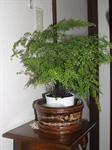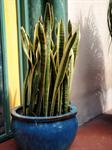
INDOOR PLANTS
Indoor plants can make a significant contribution to the "health" of an indoor environment: they help replenish oxygen in the air and help filter dust particles and pollution from the air.
In a study on indoor pollution conducted by NASA, it was proven that plants help to eliminate what is known as the 'sick building syndrome’.
Common sources of these pollutants are:
- Carpets
- Vinyl and rubber
- Wood made from pressed particles
- Office machinery e.g. photocopiers
- Gases created by cooking and also cleaning products
- Pesticides
People affected by the ‘sick building syndrome’ complain of headaches, eye irritation, skin rashes, drowsiness and other allergy-type conditions. The elimination of these harmful pollutants from the work or home environment helps to reduce sickness.
It is also suggested that plants improve staff morale - in turn improving productivity and job satisfaction.
The following is a short list of plants suggested to reduce, remove or at least improve air quality in buildings:
Aloe vera, Anthurium spp., Auraucaria heterophylla - Norfolk Island pine, Begonia semperflorens -wax begonia, Calathea makoyana - Peacock plant, Chamaedoris erumpens- bamboo palm, Chamaedoria elegans - parlour palm, Chyrsalidocarpus lutescens -areca palm, Chrysanthemum spp. Codiaeum spp. croton, Cyclamen spp. Dendrobium spp. Dracaena marginata, Dieffenbachia - dumb cane, Ficus benjamina - weeping fig, Ficus elastica - rubber plant, Maranta leuconeura - Prayer plants, Sanservieria trifasciata - Mother-in-law’s tongue, Spathphyllum - Spider plant.

Indoor plants need to be good for both people, and suited to the indor environment they are growing in. The first thing to remember about indoor plants is that they aren't really indoor plants (plants do not grow indoors in nature!). Indoor plants are simply plants which we have found to be adaptable to an indoor environment.
Usually an inside environment will differ from an outside one in the following ways:
- It has lower light intensities
- It is warmer in winter and cooler in summer
- In some rooms (e.g. kitchen, bathroom, laundry), humidity can get high
- The balance of gases in the air is different: (particularly damaging with gas heaters or air conditioning).
While many indoor plants originate in tropical areas, this by no means the case for all. The natural environment for tropical plants is usually wet, humid and hot. If those plants are placed in an indoor environment which is cooler and less humid then wetness must also be reduced.
Over-watering is a common problem with tropical indoor plants being grown in temperate regions. The best rule is: use a freely draining soil, water thoroughly once and then do not water again until the soil is absolutely bone dry. In some situations this might mean watering once very three months, in other situations once a day. The rate of watering is influenced by factors such as temperature, soil type, humidity and cannot be put down to a regular timetable. For example you cannot just assume that once a week watering is right for every plant in all conditions.
Usually temperate climate plants which are used indoors are hardier (when grown in temperate climate houses). Some are best to alternate between an indoor and outdoor position such as Cyclamen spp., ferns, Asparagus spp. (asparagus fern). Never take the plant from one environment straight to an environment which is in extreme contrast though; the move could be too much of a shock (e.g. it is better to move your ferns outside in summer and place them in a protected spot under a big tree: the change will then be minor). Avoid placing indoor plants in draughty positions or near to a gas heater or air conditioning vent. Temperatures should not drop below 5ºCelsius for the less hardy indoor plants (even overnight). Place the more exotic, tropical plants in a more humid room such as a bathroom. Low light intensity areas should be avoided for most indoor plants.
More from ACS
How safe are your building materials?
